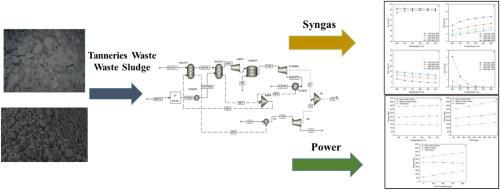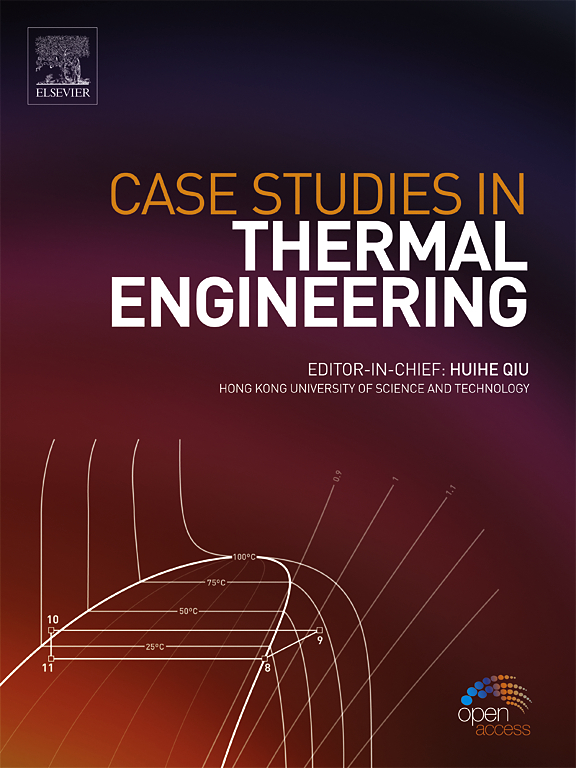利用综合热平衡模拟模型分析制革废料在气化过程中产生合成气和电力的情况
IF 6.4
2区 工程技术
Q1 THERMODYNAMICS
引用次数: 0
摘要
管理制革厂产生的高灰污泥是一项重大挑战,需要研究如何将其转化为有价值的产品。本研究探讨了利用气化工艺将制革废料转化为合成气以及利用合成气发电的问题。为此,我们使用 Aspen Plus® V12 开发了综合工艺热平衡模拟模型。该模型包括:(1) 生产合成气的蒸汽气化模型;(2) 将合成气转化为电能的发电模型。此外,还进行了敏感性分析,以确定温度(650-900 °C)、蒸汽流量(500-2000 kg/h)和 CaO 流量(0.1500 kg/h)对合成气成分和发电量的影响。恒温下蒸汽流量的变化(Cao 流量 1500 kg/h)表明,H2 含量增加到 80%,CO 和 CH4 含量下降。总输出功率从 3680 kW 增加到 4001 kW,温度从 650 °C 增加到 900 °C,蒸汽流量从 500 kg/h 增加到 2000 kg/h,功率从 3500 kW 增加到 4600 kW。最后,作为吸附剂的 CaO 对发电和二氧化碳减排的影响很大,能量输出增加到 600 千瓦以上。这项工作有助于将废物转化为能源,从而对制革业产生重大的经济影响。本文章由计算机程序翻译,如有差异,请以英文原文为准。

Analysis of syngas and power production from tannery waste via gasification process using integrated thermal equilibrium simulation model
Managing high-ash sludge from tanneries is a significant challenge and requires investigating their conversion to valuable goods. This study explores the use of gasification processes to convert tannery waste into syngas and the use of syngas for power generation. In this respect, the integrated process thermal equilibrium simulation model has been developed using the Aspen Plus® V12. This model consists of (1) a steam gasification model for syngas production and (2) a power generation model for converting syngas into electricity. In addition, sensitivity analysis has been carried out to determine the effects of temperature (650–900 °C), steam flow (500–2000 kg/h), and CaO flow (0.1500 kg/h) on the composition and power generation of syngas. Changes in steam flow rate at constant temperature (cao flow rate 1500 kg/h) show an increase in H2 content to 80 % and a decline in CO and CH4 content. This increases total power output from 3680 kW to 4001 kW, temperature increases from 650 to 900 °C, and steam flow increases from 500 to 2000 kg/h from 3500 to 4600 kW. Finally, the impact of CaO as a sorbent is significant in electricity generation and CO2 mitigation, increasing to over 600 kW of energy output. This work could contribute to converting waste into energy, which could have a significant financial impact on the tannery industry.
求助全文
通过发布文献求助,成功后即可免费获取论文全文。
去求助
来源期刊

Case Studies in Thermal Engineering
Chemical Engineering-Fluid Flow and Transfer Processes
CiteScore
8.60
自引率
11.80%
发文量
812
审稿时长
76 days
期刊介绍:
Case Studies in Thermal Engineering provides a forum for the rapid publication of short, structured Case Studies in Thermal Engineering and related Short Communications. It provides an essential compendium of case studies for researchers and practitioners in the field of thermal engineering and others who are interested in aspects of thermal engineering cases that could affect other engineering processes. The journal not only publishes new and novel case studies, but also provides a forum for the publication of high quality descriptions of classic thermal engineering problems. The scope of the journal includes case studies of thermal engineering problems in components, devices and systems using existing experimental and numerical techniques in the areas of mechanical, aerospace, chemical, medical, thermal management for electronics, heat exchangers, regeneration, solar thermal energy, thermal storage, building energy conservation, and power generation. Case studies of thermal problems in other areas will also be considered.
 求助内容:
求助内容: 应助结果提醒方式:
应助结果提醒方式:


